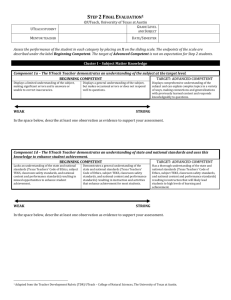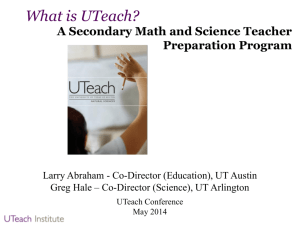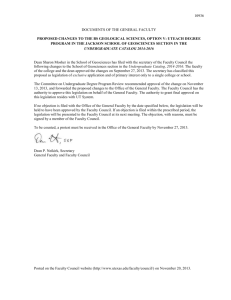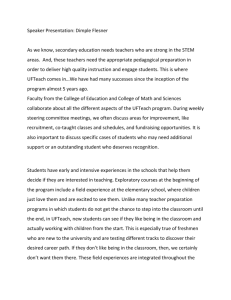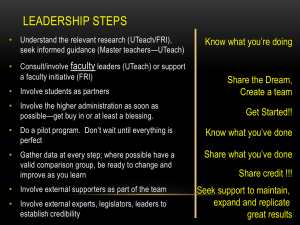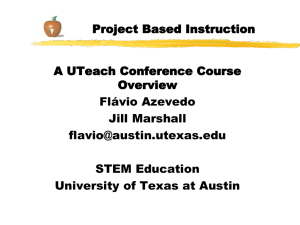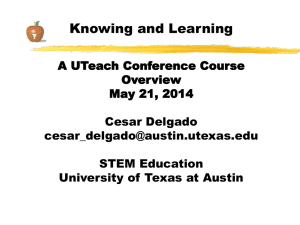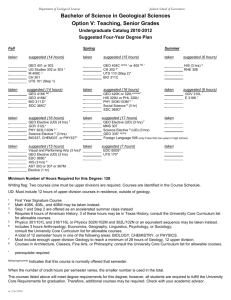Paper Title (use style: paper title)
advertisement
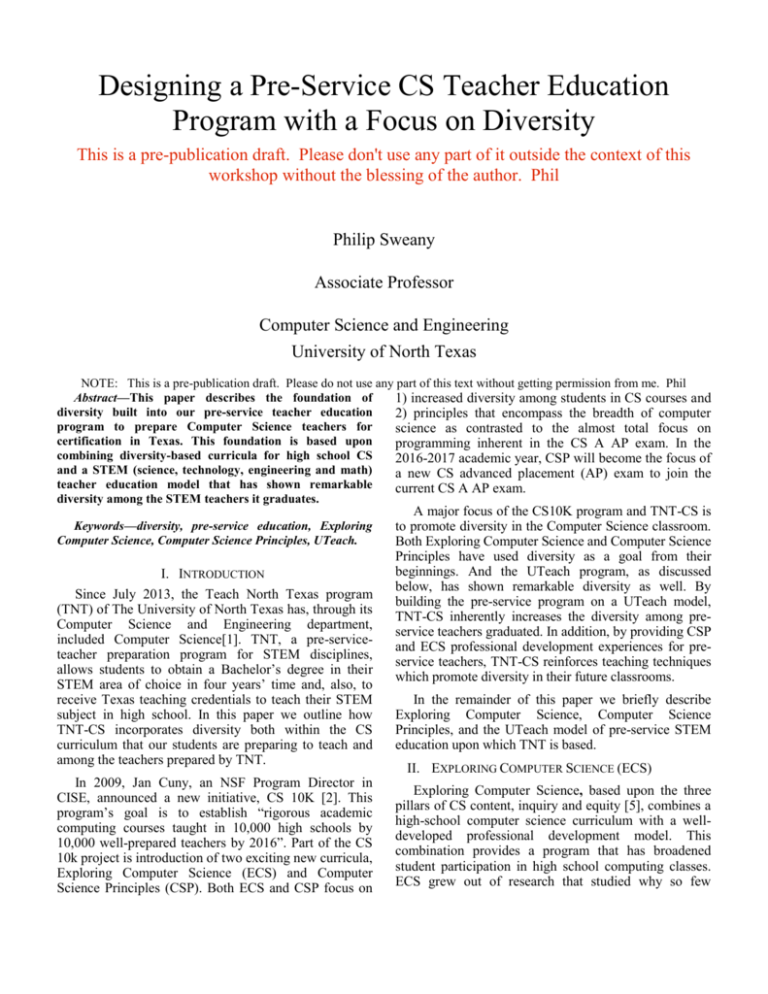
Designing a Pre-Service CS Teacher Education Program with a Focus on Diversity This is a pre-publication draft. Please don't use any part of it outside the context of this workshop without the blessing of the author. Phil Philip Sweany Associate Professor Computer Science and Engineering University of North Texas NOTE: This is a pre-publication draft. Please do not use any part of this text without getting permission from me. Phil Abstract—This paper describes the foundation of 1) increased diversity among students in CS courses and diversity built into our pre-service teacher education 2) principles that encompass the breadth of computer program to prepare Computer Science teachers for science as contrasted to the almost total focus on certification in Texas. This foundation is based upon programming inherent in the CS A AP exam. In the combining diversity-based curricula for high school CS 2016-2017 academic year, CSP will become the focus of and a STEM (science, technology, engineering and math) a new CS advanced placement (AP) exam to join the teacher education model that has shown remarkable current CS A AP exam. diversity among the STEM teachers it graduates. Keywords—diversity, pre-service education, Exploring Computer Science, Computer Science Principles, UTeach. INTRODUCTION Since July 2013, the Teach North Texas program (TNT) of The University of North Texas has, through its Computer Science and Engineering department, included Computer Science[1]. TNT, a pre-serviceteacher preparation program for STEM disciplines, allows students to obtain a Bachelor’s degree in their STEM area of choice in four years’ time and, also, to receive Texas teaching credentials to teach their STEM subject in high school. In this paper we outline how TNT-CS incorporates diversity both within the CS curriculum that our students are preparing to teach and among the teachers prepared by TNT. In 2009, Jan Cuny, an NSF Program Director in CISE, announced a new initiative, CS 10K [2]. This program’s goal is to establish “rigorous academic computing courses taught in 10,000 high schools by 10,000 well-prepared teachers by 2016”. Part of the CS 10k project is introduction of two exciting new curricula, Exploring Computer Science (ECS) and Computer Science Principles (CSP). Both ECS and CSP focus on A major focus of the CS10K program and TNT-CS is to promote diversity in the Computer Science classroom. Both Exploring Computer Science and Computer Science Principles have used diversity as a goal from their beginnings. And the UTeach program, as discussed below, has shown remarkable diversity as well. By building the pre-service program on a UTeach model, TNT-CS inherently increases the diversity among preservice teachers graduated. In addition, by providing CSP and ECS professional development experiences for preservice teachers, TNT-CS reinforces teaching techniques which promote diversity in their future classrooms. In the remainder of this paper we briefly describe Exploring Computer Science, Computer Science Principles, and the UTeach model of pre-service STEM education upon which TNT is based. EXPLORING COMPUTER SCIENCE (ECS) Exploring Computer Science, based upon the three pillars of CS content, inquiry and equity [5], combines a high-school computer science curriculum with a welldeveloped professional development model. This combination provides a program that has broadened student participation in high school computing classes. ECS grew out of research that studied why so few African-Americans, Latinos engage in high schools’ computer science courses. That research (described in Stuck in the Shallow End: Education, Race and Computing [3]) led to a pilot program in the Los Angeles Unified School District (LAUSD) that evolved into the ECS program, which currently serves over 2,000 students every year. Current data from LAUSD (May 1, 2014) show that in ECS classes , 43% of the students are female, 77% are Latino and 9% are African-American which compares well to overall LAUSD demographics of 50%, 73%, and 10%, respectively [4]. Based largely on its success in LAUSD, ECS has now spread to Chicago, Washington D.C., Santa Clara and to schools in Oregon, Utah and Maine. The ECS curriculum, a year-long course, consists of six units: 1) Human-Computer interaction, 2) Problem Solving, 3) Web Design, 4) Programming, 5) Computing and Data Analysis and 6) Robotics. Instruction is inquiry-based, with social issues included throughout all units, and each unit includes a final project. However as Goode, et al. emphasize, 10K project. An early goal of CS 10K was to build curricula to support a new Advanced Placement (AP) exam for computer science that would focus less on Java programming and more on central principles of computer science. The first step in that process was the development of six “computational practices” and seven “big ideas” [6]. The 6 Computational Practices are 1) Connecting Computing, 2) Developing Computational Artifacts, 3) Abstracting, 4) Analyzing Problems and Artifacts, 5) Communicating, and 6) Collaborating. CPS’s 7 Big Ideas are 1) Computing is a creative activity, 2) Abstraction reduces information and detail to facilitate focus on relevant concepts, “ECS is a program that includes the ECS curriculum in combination with ECS teacher professional development. Our experiences with observations in classrooms and interviews with teachers show the complexities of teaching for broadening participation in computing, and that simply adopting the curriculum without sustained professional preparation is insufficient to develop the particular pedagogical strategies and classroom norms that must accompany the ECS curriculum.” [5] 3) Data and information facilitate the creation of knowledge, To address this, ECS has cultivated a strong program to prepare teachers. ECS’ professional development includes four phases: In the 2010–2011 academic year, five universities received funding to develop and implement curricula based upon the 7 Big Ideas and 6 Computational Practices [7]. Those five pilot projects produced the first examples of CSP curricula. Working with those curricula, CSP developers recruited additional universities and high schools as pilot schools, including The University of North Texas. In addition to the original pilots, now more than 50 high schools and universities function in this capacity and provide information to the College Board. In turn, the College Board has used this information in preparing their new CSP AP exam, which they plan to offer in the 20162017 school year. 1. a week-long summer workshop for teachers before they first teach ECS, 2. quarterly Saturday workshops focused on the three pillars and upcoming curriculum units, 3. classroom visits by ECS coaches that provide individualized support and 4. deepening of content and pedagogy in years 2 and beyond. In short, Exploring Computer Science requires significant resources in professional development but the results have proven well worth the cost. COMPUTER SCIENCE PRINCIPLES (CSP) Computer Science Principles is a curriculum framework developed and implemented as part of the CS 4) Algorithms are used to develop and express solutions to computational problems, 5) Programming enables problem solving, human expression and creation of knowledge, 6) The Internet pervades modern computing, and 7) Computing has global impacts. Much as CSPs curricula have greater diversity than that of ECS, the CSP professional development for inservice teachers takes many flavors, from blended 6week courses where the first and sixth week are face to face with four weeks of online instruction in between to a six-week face to face experience. There is also a MOOC available so that in-service teachers can do the entire professional development experience online. [8] THE UTEACH MODEL UTeach, established at University of Texas provides a teacher preparation program for secondary teachers of STEM subjects [9]. UTeach, developed and maintained as a collaborative project of the UT Education College and the College of Natural Sciences, allows UTeach students complete a Bachelor’s degree in their chosen STEM field and, also, to take education courses that allow them to become certified secondary-school teachers in their chosen field. The UTeach model includes several key components described in [9, 10]. Students visit local school classrooms both as observers and as teachers throughout their pedagogy courses. Pedagogy focuses on inquirybased learning with a strong component of project-based instruction. That the first two UTeach courses both contain several experiences in the local school classrooms leads to an interesting phenomenon. UTeach students quickly discern whether teaching interests them. So, while retention in the first two courses remains low, once students have completed those courses, they tend to complete the program. Given the large number of experiences in local classrooms, the logistics of these visits, and the breadth of subject matter (math, chemistry, biology, physics), a main tenant of the program is the use of “Master Teachers.” These faculty teach courses in the professional development of preservice teachers in individual STEM areas, coordinate field and clinical experiences to include orientation of mentor teachers, supervise UTeach students in the field, and build community between UTeach students and faculty as well as with local school-district personnel. Ideally, a UTeach program includes sufficient master teachers to have at least one with expertise in each field of study included in the STEM curricula. A major focus of UTeach requires building a strong sense of community among the students, no doubt also leading to high completion rates once the first two courses have been completed. Another key piece in the UTeach model is a strong induction program to encourage the graduates to remain in teaching once they take a job. UTeach’s early success led to funding from the National Math and Science Institute (NMSI) and others to fund other universities to replicate the UTeach program. In 2008, the first cohort of 17 replication sites, including The University of North Texas, began their programs [11]. Currently 44 universities across the US are implementing the UTeach model, including 8 in Texas [12]. The President’s Council on Science and Technology, in a 2010 report, recommend UTeach programs as exemplary in addressing the need for improved STEM education [13]. That report points out that UTeach model programs attract students with SAT and ACT scores higher than that university’s undergraduate population as a whole. They further note that 82% of UTeach graduates are still teaching which compares favorably to national retention rates of less than 60%. The report also lauds the UTeach program for the fact that 45% of the graduates have chosen to teach in high-need schools, a fact that the report claims is related to UTeach’s strong emphasis on public service. Finally, the report suggests that when the UTeach model reaches 200 schools, it will sustain a pipeline of 10,000 STEM teacher graduates per year. As the President’s Council report suggests, UTeach, much like ECS and CSP, fits well within CS 10K’s focus on increasing both numbers and diversity of students engaged in high school STEM courses, in this case by producing high-quality and diverse teachers of STEM subjects. As of spring 2014, UTeach and UTeach-model programs had graduated 2,153 STEM teachers [11]. That same report indicates that 67% of those graduates are women and 17% of graduates come from underrepresented American Indian, Hispanic or African American populations. This increase in the diversity of teachers of computer science in our high schools will provide students of underrepresented groups to visualize computer science as a viable career choice—a major goal in STEM. Finally, the UTeach Institute 2014 report [12] indicates that 64% of the UTeach-model graduates are teaching in high-needs schools, a significant improvement over the results from the 2010 President’s council. And, again, the higher visibility of these teachers will encourage high school students to pursue careers related to computer science. And, finally, [12] projects that by 2020, with current trends, there will be a cumulative count of 8300 UTeachmodel graduates. This is all very impressive. WHERE TO GO FROM HERE By combining ECS and CSP preparation in TNT-CS we have a comprehensive plan for preparing a diverse group of teachers who have a bachelor’s degree in their chosen field and a strong pedagogical background. This is ensured by the UTeach (and thus TNT) emphasis on both a 4-year STEM degree and a well-tested model of pedagogy that has shown excellent results. In addition, by introducing the TNT-CS students to ECS and CSP professional development, our pre-service teachers are given a strong foundation in the motivation and praxis of enhancing the diversity within computer science. But work remains to be done. It is impressive that there have been over 2000 UTeach-model graduates to date. But only 12 of those graduates are prepared as CS teachers, primarily because CS has not been included as a STEM field. As of now, of the 44 UTeach model universities, only UNT includes CS in its UTeach program. This is due in part to the fact that, to get more CS teachers in the high school classrooms as soon as possible, CS 10k has focused more on professional [5] development of in-service teachers than pre-service programs. Unfortunately, these in-service teachers, drawn from related fields, typically lack a solid foundation in computing principles and pedagogy. Mark Guzdial in [14] argues that, to have a reliable stream of well-trained CS teachers in high schools, computer scientists need to focus much more on preservice programs rather than in-service professional development. Not only would pre-service programs lead to teachers with more substantial Computer Science background, but once the pre-service pipeline is established with significant programs and numbers of students, the production of future CS teachers, like those of other STEM subjects, would be endemic in the “normal” teacher preparation methods rather than focused on expensive professional development of current in-service teachers who lack significant academic Computer Science credentials. Guzdial goes on to say that pre-service education in STEM subjects must be based in schools and programs of education, not in the STEM disciplines of choice. This enables preservice students to focus on appropriate teaching pedagogies. However, as you might expect given UNT’s TNT-CS program, we feel that a cooperative approach seems better equipped to handle pre-service needs then either a solely CS or a solely education program approach. And other UTeach sites are beginning to move in that direction. At least six UTeach sites submitted proposals to NSF this year for funding for in-service programs. Let’s hope (and work) for continued growth in this realm. [6] [7] [8] [9] [10] [11] [12] [13] REFERENCES [14] [1] [2] [3] [4] Teach North Texas. University of North Texas, 6 Apr. 2015. Web. 06 Apr. 2015. Snodgrass, Richard. "Ubiquity Symposium: The Science in Computer Science Broadening CS Enrollments: An Interview with Jan Cuny." Ubiquity. ACM, Feb. 2013. Web. 23 Jan. 2015. Margolis, Jane, Rachel Estrella, Joanna Goode, Jennifer Jellison-Holme, and Kimeberly Nao. Stuck in the Shallow End: Education, Race, & Computing. MIT Press: Cambridge, MA. 2008. Print. "Summary of Student Indicators for ECS-LAUSD." ECS: Exploring Computer Science. Exploring Computer Science, 1 May 2014. Web. 6 Apr. 2015. Goode, Joanna, Jane Margolis, and Gail Chapman. (2014). “Curriculum is not enough: The educational theory and research foundation of the exploring computer science professional development model.” In Proceedings of the 45th ACM Technical Symposium on Computer Science Education. 2014: 493-98. Print. Astrachan, Owen, and Amy Briggs. “The CS Principles Project.” ACM Inroads, 3.2: 38-42. June 2012. Print. Snyder, Lawrence, Tiffany Barnes, Dan Garcia, Jody Paul, and Beth Simon. “The First Five Computer Science Principles Pilots: Summary and Comparisons”. ACM Inroads, 3.2:54-57. June 2012. Print. Gray, Jeff. "CS Principles for High School." CS Principles -- CS4H2 (MOOC). University of Alabama, May 2014. Web. 13 Apr. 2015. "UTeach Programs Nationwide." The UTeach Institute. University of Texas at Austin, Jan. 2014. Web. 27 Mar. 2015. "UTeach Curriculum Snapshot." The UTeach Institute. University of Texas at Austin, March. 2013. Web. 27 Mar. 2015. "UTeach and UTeach Expansion." The UTeach Institute. University of Texas at Austin, Oct. 2014. Web. 27 Mar. 2015. "UTeach Programs Nationwide." The UTeach Institute. University of Texas at Austin, Jan. 2015. Web. 27 Mar. 2015. President’s Council of Advisors on Science and Technology. Report to the President: Prepare and Inspire—K-12 Education in Science, Technology, Engineering, and Math (STEM) for America’s Future. Executive Office of the President. The White House. Sept. 2010 (PDF) 23 March 2015. Guzdial, Mark. "A Stable Future for Computing Education Requires Collaboration Beyond CS." Weblog post. Communications of the ACM. ACM, 22 Aug. 2003. Web. 23 Mar. 2015.
